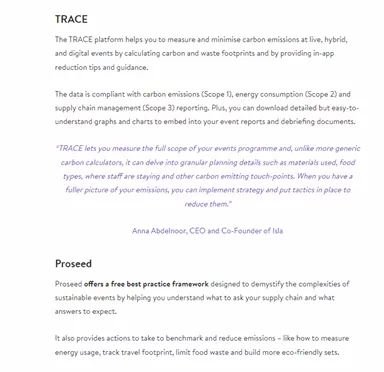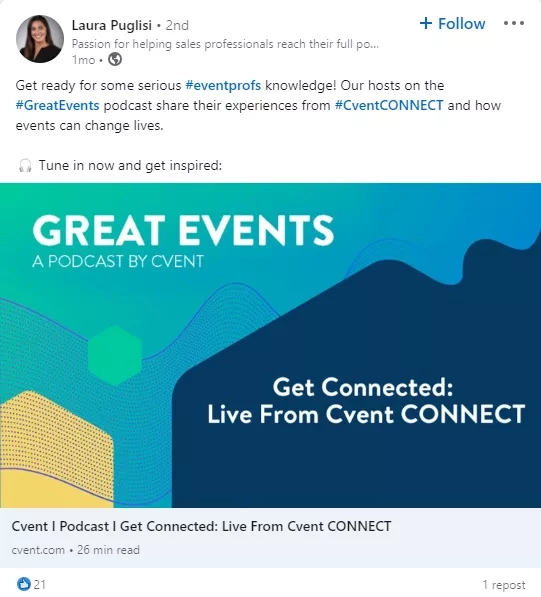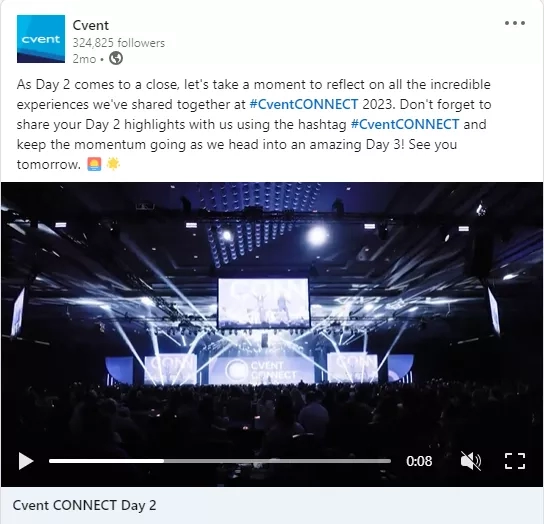When you’re dealing with limited budgets, maximising your event’s return on investment (ROI) isn’t an easy task. But did you know that repurposing your event content helps you solve this challenge?
After spending months crafting impactful scripts, handouts, and presentations, many event marketers miss this golden opportunity. Repurposing your event content allows you to stretch your events further. This means more leads, more brand awareness, better audience engagement, and less work.
Read on to learn how to create great content for your events and repurpose it effectively across other marketing channels to reach new audiences, increase ROI, and build your brand.
Why should I repurpose my event content?
People forget information within the first few days (or even hours) of hearing it, according to the Ebbinghaus Forgetting Curve. Repurposing your event content is a great way to keep that information fresh in your audience’s minds, even after your event has long finished.
Here are other advantages of repurposing your event content:
- Save time: Creating and distributing event content from scratch takes time. Each piece—whether it’s a blog, webinar, or quiz—must be engaging, informative, and relevant to your audience. And as an event marketer, your time is precious.
- Extend value: Instead of content becoming obsolete after the end of your event, repurposing it allows you to leverage that value for an extended period.
- Reach a wider audience: Repurposing your content allows you to engage creatively with your audience before and after your event. This audience will also be broader and more diverse— for example, people who may not have been able to attend your webinar or event. Recycling this content into different formats also helps you cater to different learning styles.
- Reinforce your message: Repetition is key to reinforcing messages. By repurposing content, you can maintain a consistent message and keep your audience engaged over time. Consistency helps build trust and brand recognition.
- Generate leads: Content such as e-books, whitepapers, and webinars can serve as valuable lead magnets. By repurposing event content into lead-generation assets, you can capture new leads and grow your email list.
- Establish thought leadership: Panel sessions, Q&As, and other discussions often generate invaluable insights for your audience. Repurposing these sessions into blogs or webinars, for example, will establish you as a thought leader in your industry.
- Maximise your budget: Repurposing event content maximises your marketing budget and frees up time to focus on other marketing activities.
- Understand audience interests: Transforming your event content into trackable formats, such as blogs, webinars, or videos, allows you to monitor interest over time. This will show you how long your audience spends on the page and what formats and topics work best.
💡Check out more top tips on how to repurpose your event content in our Great Events podcast:
3 Real-life repurposing examples you can steal
Cvent CONNECT Europe is our annual tradeshow where we invite event and hospitality professionals to network and learn. Last year, we repurposed content from the event in three key ways and found success. Here’s how:
1. Create short video snippets for social media
We extracted the most impactful snippets from our sessions and turned them into short videos. Sharing these snippets on social media allowed us to share the most important and interesting insights from our event.
For example, this session covers strategies to keep your audience engaged before, during, and after your event:
We repurposed the session into a short video clip focused on the three key digital trends that will increase your event engagement:
2. Write informative blog posts
We also held a session on sustainability, full of useful ways for companies to lessen their impact on the environment and deliver more sustainable events.
To make this information easily accessible to our audience looking for sustainability tips, we turned it into a long-form blog post. We shared tips, steps to success, and the most impactful quotes from the session.
3. Create multiple assets
Last year, Centennials—otherwise known as Generation Z—turned twenty-five. To give our event planner and marketer audience some insight into what this means for the industry, one of our sessions addressed this shift.
Since it was a hugely popular and highly-rated session, we decided to repurpose it in two ways: by writing a dedicated blog post on what event marketers should know about Gen Z and hosting a webinar on the same topic.
11 creative ways to repurpose your event content
1. Blog posts
High-quality blogs, posted with a regular cadence, are a must for every organisation looking to attract website traffic. And your event content is perfect for the job. It’s a treasure trove of insights, information, and opinions from trusted thought leaders.
First, begin with a plan. Outline what event materials will be repurposed into which blogs. Collect images or visuals from your event to include. Decide how many blogs you think you could get from your event and determine a posting schedule.
Take your most attended or highly-rated sessions and use the transcripts to create in-depth blogs. Outline your piece and create sections based on the session’s segments.
Blogs will work best if you can create them with search engine optimisation (SEO) in mind. Find relevant keywords—with a good monthly search volume and low to medium competition—to thread throughout each blog.
💡Pro tip: If you’ve got a content marketer or copywriter on your team, you’re in luck! Invite them to sit in on each session to take notes. Then, work with them to come up with blog ideas based on their notes.
2. Email marketing
Post-event email marketing is non-negotiable. But what if you went a step further and used your event content to create interesting, valuable emails?
Whether you’re emailing attendees or no-shows, referencing specific and interesting session content helps you grab their attention. Add images from a few choice sessions with small quotes or descriptions to drive your audience to on-demand content.
💡Pro tip: Use email marketing to share key takeaways from each of your sessions. The more actionable they are, the better.
3. Webinars
Not all of your event content will be right for a webinar, such as sessions with a heavy focus on audience participation. Instead, pick content that is informative, engaging, and conducive to a webinar format, like panel sessions, keynote speeches, or presentations.
There are two options where webinars are concerned. You could make the session on-demand and do little to the content except add audience participation elements like polls. This is a low-effort way to extend the value of interesting sessions.
But why not go a step further and invite your speakers back for a follow-up session? Here, you could discuss the topics from your session and add fresh insights.
💡Pro tip: Encourage audience participation by including live Q&A sessions, chat, or discussion breaks.
4. Case studies and testimonials
If you invited customers to participate in your sessions, this is a great opportunity to turn their insights into written or video testimonials. Did they speak at length about your product/s? Or did they make a passing comment? It doesn’t matter. All of it can be repurposed.
At Cvent CONNECT Europe, we invite our customers to partake in interviews about their experience of the event and the Cvent products they use. This allows us to turn their insights into written case studies, graphics, and videos. We post these on our website and social media.
Capturing the experience of your customers in written or video form creates credibility and content for sales to pass on to prospects.
💡Pro tip: Seek permission from clients to use their name, company, and testimonial even if they made the comment in a session.
5. Podcast episodes
Podcasts provide an opportunity for you to enhance your brand visibility, establish thought leadership, and connect with your target audience. But coming up with content can be the difficult part.
Repurposing your event content for podcast episodes saves you time brainstorming topics and scripts. As with webinars, you have two options: Either you can take your event’s recording and edit the audio into a podcast or re-record with the same speakers. The latter option allows you to add fresh insights.
Audio quality is crucial for podcasts, given there is no visual content. Clean up background noise and cut out any irrelevant portions. You’ll also need to add an intro and outros, transitions, and narration.
💡Pro tip: Have your podcast hosts share personal stories from your event, like ours do in Cvent’s podcast, Great Events. These could include what they learned, funny anecdotes, or their previous event experiences. You can then ask colleagues to share this with their network on social media.
6. Explainer or how-to videos
Repurposing event content into explainer videos is an effective way to engage your audience and simplify complex concepts.
Whether you create product explainer videos, educational videos, or testimonials, the possibilities are endless. For example, gather sound bites of customers talking about a particular product and stitch them together.
First, storyboard your content. Plan your video’s flow and structure, outline the main scenes, and decide what type of animation you’d like. Consider whether a voiceover or narration is necessary.
💡Pro tip: Keep your videos between two minutes or less. Although, ideal video lengths vary depending on the platform and type of content.
7. eBooks
eBooks are long-form assets that allow you to encapsulate and extend the value of all of the information and insights shared at your event. Make sure to choose event content that is high-value and evergreen. This includes thought-provoking presentations, research findings, or keynotes.
Although your sessions will lend a structure and a basis for the content, it helps to devise an outline before you dive in.
💡Pro tip: Gather all the information you need before jumping in, as well as new research, statistics, or learnings. If you need to get the ebook signed off by leadership, providing as much information upfront streamlines the experience and prevents frustration.
8. Infographics
Infographics allow you to convey complex information in a visually engaging and easily digestible format. These are great options for sharing research data, quotes, or educational content.
You could make long-form, scrollable infographics, or carousels for social media. Whichever you choose, simplification and clarity are key.
💡Pro tip: Establish a visual hierarchy to guide readers through the infographic using headings and varying font sizes.
9. Quizzes
Quizzes are a fun and interactive way to engage your audience while reinforcing key information.
You’ll first need to determine your primary objectives. Are you aiming to test your audience’s knowledge, reinforce key takeaways from sessions, or simply engage? These objectives will influence the look and feel of your quiz and the call to action at the end.
💡Pro tip: Include varied questions to keep your audience on their toes, such as true/false statements, multiple choice, or fill-in-the-blanks.
10. Social media posts
Get your audience to relive the event experience through quotes, videos, or images. This increases the chance they’ll sign up for your next event, watch on-demand content, or engage with you.
Whether you’re posting on Facebook, LinkedIn, or Instagram, make sure each post is optimised for each platform. Different platforms have varying character limits, image sizes, and engagementdynamics. Customise your content accordingly.
💡Pro tip: Encourage your audience to share social media posts using your event-specific hashtags. This type of marketing allows you to spread the word without the heavy lifting.
11. Online courses and workshops
If you hosted sessions on product best practices, edit and repackage your event content into online courses and workshops. These could be short videos on YouTube, or full, gated resources on your website.
While you could re-post session recordings, you must make sure the presentation is engaging, clear, and structured. Instead, consider re-recording using an existing script and altering it so the presenter is talking to the camera instead of an unseen audience.
💡Pro tip: Enhance the course by adding supplemental materials such as slides, transcripts, additional reading resources, and quizzes to increase engagement.
How else can I repurpose my content?
Repurposing your event content doesn’t always have to mean creating a new piece of content. Let's look at how:
- Extract key themes: It’s impossible to be creative all the time. Past events are a great place to go digging for ideas when you’re stuck. Find out what content was most appealing to your audience and use those as a jumping-off point for your next blog, webinar, or podcast.
- Reuse quotes: Your past events, whether virtual or in-person, are full of hard-hitting, interesting quotes. These are particularly useful when writing blogs, eBooks, or case studies. Quotes add a level of credibility and authenticity to your content.
- Reuse speakers: Looking for a good speaker for your next podcast or webinar? Go through your past events and find speakers that your audience resonated with. Look for charismatic, natural public speakers to maximise engagement.
- Update existing content: Use fresh insights from your events to continually update and refresh older content. This helps you keep content up-to-date and search engine optimisation-friendly, and saves you having to come up with new content.
Best practices for a winning event content strategy
Repurposing event content only works if you have a good event content strategy in place. Consider how you promote, distribute, and measure your success.
Plan your repurposing strategy ahead of time
Before your event takes place, put some thought into how you plan to repurpose the content. What formats will you use? What topics do you think will resonate most? Work with your content marketing team or copywriters to outline the content you’d like to create.
It may even be worthwhile to organise for speakers or customers to come back for a post-event webinar or podcast. Getting these in the diary ahead of time will save you time and stress.
Promote your content
What’s the point of creating content if no one sees it? Promoting your content through the right channels is essential.
- Email marketing: Send targeted email campaigns featuring repurposed content to your subscribers. Segment your email list for personalised content recommendations.
- Social media sharing: Create engaging social media posts with eye-catching visuals, compelling captions, and relevant hashtags. Schedule posts at optimal times for your target audience.
- Paid promotion: Invest in paid advertising to boost the visibility of your repurposed content, especially if you have a specific audience segment you want to reach.
Have a content distribution strategy
Your distribution strategy will help you stay organised and derive the most value possible from your repurposed content.
- Multi-platform approach: Distribute repurposed content across various platforms, including social media, YouTube, content-sharing platforms, and your website.
- Customise for each platform: Tailor the content for each platform to ensure it aligns with the platform's audience and format requirements.
- Create a distribution schedule: A distribution schedule helps you maintain a regular publishing cadence and diversify content types. Schedules also help you allocate time, personnel, and budgets efficiently.
Measure performance
Before you begin sharing your content, consider how you intend to measure success.
- Set KPIs: Define key performance indicators (KPIs) to measure the success of your content repurposing efforts. Common metrics include website traffic, engagement rates, conversions, and lead generation.
- Analytics tools: Use analytics tools, such as Google Analytics, social media analytics, and email marketing analytics, to track and analyse the performance of your repurposed content.
- A/B Testing: Conduct A/B tests to optimise content elements, such as headlines, visuals, and CTAs, to improve performance and achieve better results.
After a fantastic event, repurposing its content into blogs, quizzes, and webinars, for example, saves time and provides your audience with ongoing insights and value. However, content repurposing must be approached strategically. How will you promote and distribute your content? How will you measure your success? These are the key questions to help you make the most of your event content.










